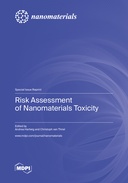Explore

Risk Assessment of Nanomaterials Toxicity
0 Ungluers have
Faved this Work
Login to Fave
Regarding the increasing use of nanomaterials in almost every area of our daily life, toxicological risk assessment is one of the major requirements for their safe handling. Especially at workplaces, inhalation is the major route of exposure and potential toxicity, and effects on the lung need to be considered. Furthermore, neurotoxicity associated with exposure to nanomaterials is a growing field of scientific investigation. However, not every single nanomaterial can be assessed in long-term animal inhalation studies, due to limited resources as well as political and societal efforts to reduce animal experiments according to the 3R principles. Thus, during the last few years, significant efforts have been dedicated to grouping nanomaterials, mainly based on advanced in vitro models. These new approach methodologies (NAMs) include detailed characterization of the respective materials in physiologically relevant media, but also more realistic exposure systems, such as co-cultures, also at the air–liquid interface, combined with comprehensive cellular investigations that provide quite detailed toxicological profiles. Thus, nanoparticles show differences in toxicity depending on their size, surface reactivity, and dissolution kinetics. Adverse cellular effects include inflammation, genotoxicity, oxidative stress, and epigenetic alterations. This Special Issue aims to highlight the recent advances in the mechanisms of nanomaterial toxicity, as well as the approaches for risk assessment, linking nanoparticle characteristics as well as in vitro toxicity to in vivo observations for advanced risk assessment.
This book is included in DOAB.
Why read this book? Have your say.
You must be logged in to comment.
Rights Information
Are you the author or publisher of this work? If so, you can claim it as yours by registering as an Unglue.it rights holder.Downloads
This work has been downloaded 65 times via unglue.it ebook links.
- 65 - pdf (CC BY) at Unglue.it.
Keywords
- 2D
- 3D spheroids
- A549
- Advanced materials
- agglomerates
- agglomerates and aggregates
- air-liquid interface
- ALI—air–liquid interface
- alveolar epithelium
- BEAS-2B
- bronchial epithelium
- carbon nanotubes
- cell death pathways
- chromosomal damage
- ciliary beating frequency
- comet assay
- Cr(VI) release
- Cr2O3 particles
- Cytokines
- Cytotoxicity
- Database
- description standards
- DNA Damage
- DNA damage signaling
- DNA repair proteins
- DNA strand breaks
- Endocytosis
- engineered nanomaterials
- ENM interference
- FADU assay
- gene expression profiles
- gene regulation
- genotoxicity
- Graphene
- hazard assessment
- hazard testing
- in vitro
- in vitro methods
- in vitro models
- Inflammation
- inhalation
- interlaboratory comparison
- intracellular bioavailability
- Lung
- lung toxicity
- metal-based nanoparticles and nanowires
- minimal information
- n/a
- NAMs—new approach methodologies
- nanomaterials
- Nanoparticles
- nanoplates
- nanotoxicology
- NM-300K
- NR4A1
- osteoblasts
- oxidative reactivity
- Oxidative Stress
- pulmonary toxicity
- quality criteria
- realistic exposure in vitro
- respiratory tract
- SAbyNA
- safe-by-design
- solubility
- study quality
- synthetic amorphous silica
- Technology, engineering, agriculture
- Technology: general issues
- TiO2 NPs
- titanium dental implants
- titanium dioxide
- Toxicity
Links
DOI: 10.3390/books978-3-0365-7813-2Editions

